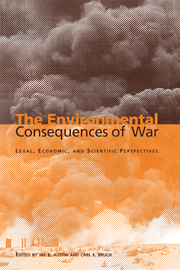Book contents
- Frontmatter
- Contents
- List of illustrations
- List of tables
- List of contributors
- Acknowledgements
- Foreword by Klaus Toepfer
- Introduction
- Part I General principles
- Part II The legal framework
- Introduction
- 2 The law of war and environmental damage
- 3 War and the environment: fault lines in the prescriptive landscape
- 4 The inadequacy of the existing legal approach to environmental protection in wartime
- 5 United States Navy development of operational-environmental doctrine
- 6 In furtherance of environmental guidelines for armed forces during peace and war
- Introduction
- 7 Peacetime environmental law as a basis of state responsibility for environmental damage caused by war
- 8 Environmental damages under the Law of the Sea Convention
- 9 The place of the environment in international tribunals
- 10 Civil liability for war-caused environmental damage: models from United States law
- Part III Assessing the impacts – scientific methods and issues
- Part IV Valuing the impacts – economic methods and issues
- Part V Prospects for the future
- Index
6 - In furtherance of environmental guidelines for armed forces during peace and war
Published online by Cambridge University Press: 04 August 2010
- Frontmatter
- Contents
- List of illustrations
- List of tables
- List of contributors
- Acknowledgements
- Foreword by Klaus Toepfer
- Introduction
- Part I General principles
- Part II The legal framework
- Introduction
- 2 The law of war and environmental damage
- 3 War and the environment: fault lines in the prescriptive landscape
- 4 The inadequacy of the existing legal approach to environmental protection in wartime
- 5 United States Navy development of operational-environmental doctrine
- 6 In furtherance of environmental guidelines for armed forces during peace and war
- Introduction
- 7 Peacetime environmental law as a basis of state responsibility for environmental damage caused by war
- 8 Environmental damages under the Law of the Sea Convention
- 9 The place of the environment in international tribunals
- 10 Civil liability for war-caused environmental damage: models from United States law
- Part III Assessing the impacts – scientific methods and issues
- Part IV Valuing the impacts – economic methods and issues
- Part V Prospects for the future
- Index
Summary
Background
Unsustainable discharges of waste gases into the atmosphere and large numbers of species extinctions throughout the world are but two of many indications of the increasingly deleterious impact of humankind on the global biosphere. With the civil sector of society responsible for most of this abuse, it is only natural that attempts at ameliorative action are directed almost exclusively towards that sector. However, a number of arguments readily suggest the importance of not overlooking the military sector of society in conserving the environment.
First, although military activities now contribute only about 3 percent to total human activities worldwide (as measured in terms of gross national products), every bit of ameliorative action is valuable in the increasingly dire environmental circumstances prevailing today. Second, some military activities have the potential for being environmentally disruptive at levels disproportionately high in relation to their contribution to overall human activities, thus requiring particular attention. Such examples include, among others: the Yellow River Valley (1938), Gruinard Island (1942), northern Norway (1944), Hiroshima and Nagasaki (1945), Enewetak (Eniwetok) Atoll (1952), Vietnam and Laos (1970), Kuwait and the Persian Gulf (1991), Eritrea (1991), abandoned military bases in Estonia and Latvia (1991), and Cambodia (1992). Third, there is a tendency for the military sector to consider itself immune from applicable restraints on environmental abuse, especially during wartime, but also during peacetime. Fourth – some would add – the military sector to some extent does not contribute to human welfare and thus becomes a prime candidate for curtailment.
- Type
- Chapter
- Information
- The Environmental Consequences of WarLegal, Economic, and Scientific Perspectives, pp. 171 - 182Publisher: Cambridge University PressPrint publication year: 2000
- 3
- Cited by



